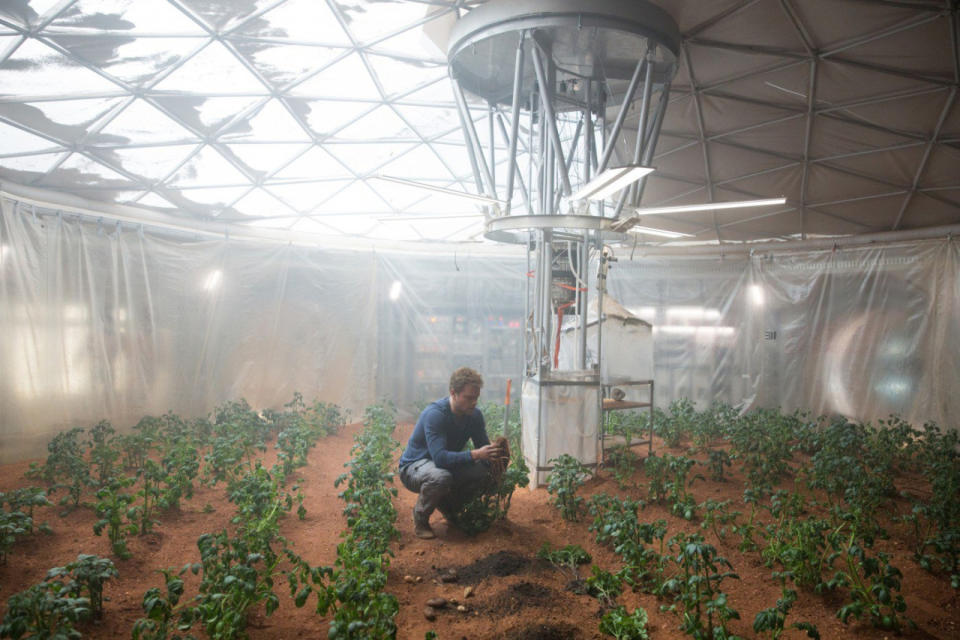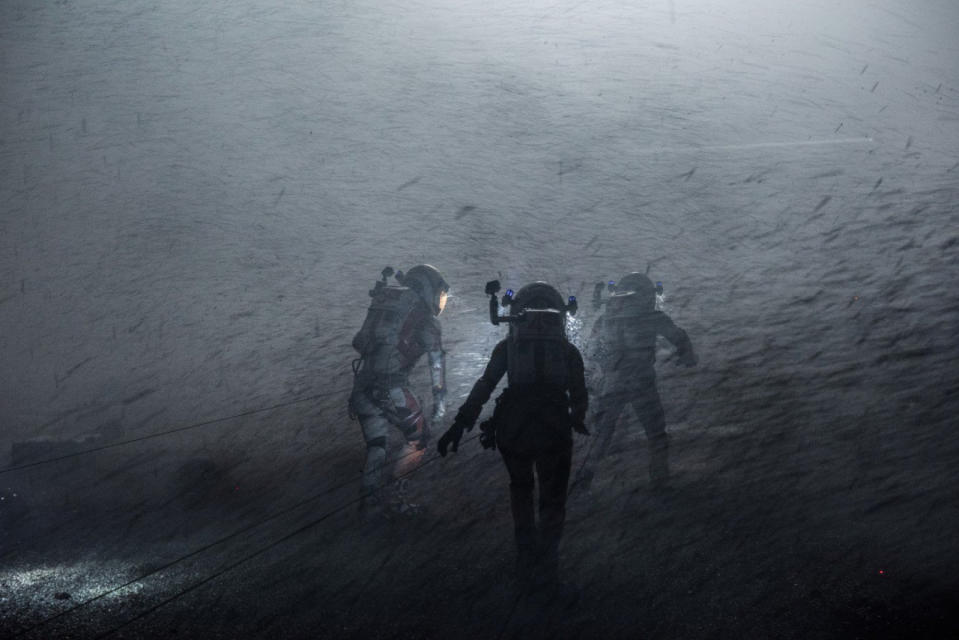How Realistic Was The Martian?

‘The Martian’ was one of the biggest commercial and critical hits last year, and will be competing at the Oscars after picking up seven nominations.
The film stars Matt Damon as Mark Watney, an astronaut left to fend for himself on the surface of Mars after he is left for dead by his crew after a massive dust storm. Rather than despair, he decides to “science the s**t” out of the many problems he faces trying to stay alive and (eventually) escape.
One of the elements that the film was praised for was its realism – ‘The Martian’ is a celebration of science, and the filmmakers really did their homework, extensively collaborating with NASA during production.
But how accurate is it? And how plausible is a mission to Mars? Who better to tell us than NASA themselves. At the NASA Johnson Space Centre in Houston, Yahoo spoke to some of the brightest minds in the agency, who broke down what was fact and fiction in ‘The Martian’.
Spoilers below.
Growing potatoes
When Mark Watney is stranded on Mars, he must grow food to survive. Cue several surprisingly thrilling and hilarious sequences showing Watney create an improvised potato farm in the Martian soil with the help of vacuum-packed human waste (see below).

Amazingly, this would be possible in real life, according to Dr. Vickie Kloeris, the Manager of the ISS Food System at NASA. “I think it could be possible, given the right infrastructure,” she said. “NASA’s done a lot on ground-based tests here with wheat and other crops to look at how crops could help recycle air in water for a closed environment. I certainly think given a certain infrastructure you could do it but you’re certainly not going to be able to on your first mission to Mars because you wont have that infrastructure.”
NASA has already successfully grown a number of crops in low-Earth orbit on the international Space station, most successfully lettuce. Eating that for years on end would be even more depressing than potatoes.
Food from home
A bigger problem for Whatney could be the food that was sent up to Mars from Earth, according to Dr. Kloeris.
“The first food sent to Mars is probably going to be Shelf Stable Food Systems products similar to what we have now,” she says. “But the challenge is making these products last as long as it will take to do a Mars mission. The food will go out in an unmanned cargo vehicle in advance and will be waiting for them in orbit or on the surface. [NASA] are going to verify that it’s there intact before they launch the crew. So what that means is that the food that those crew eat on the return flight will probably be 5-7 years old. We can make food from a microbiologic perspective that’ll last that long and be safe to eat but the problem is what nutritional content it will have and how palatable it will be. They are commercially sterile and all the bacteria has been killed, but chemical changes continue to occur and nutrients degrade over time.”
Another problem for this food is what years of exposure to the radiation in space will do it.
“Radiation in transit is the big unknown at this point,” says Dr. Kloeris. “We have sent up food for extended time in space stations then brought it back and analysed it on the ground and the radiation is not an issue, but that is lower-Earth orbit. The radiation in deep space is different. It could change the colour and texture or nutritional value of the food. We don’t know. [NASA] are talking about sending food to a waypoint on the moon, leaving it in a vehicle then sending it back to analyse it.”
Radiation
In fact, radiation seems to be the biggest barrier to recreating ‘The Martian’ in real life at the moment.
“I don’t think we’ve solved the radiation problem yet,” says Astronaut Andrew Feustel. “And that’s because of how fast we can get there. The faster we can get there, the less radiation people travelling to Mars are exposed to. We have the technology to get to Mars, NASA is building a heavy lift rocket space launch system that will carry an astronaut. But really what we need is to get an astronaut into space and then to hook it up to something that is a lot faster than a chemical rocket to get us to Mars and back in a short period of time, so that we don’t get x-rayed the whole way there. The shorter the better, but three months would be good. To go there right now it’s on the border of a year in a chemical rocket.”
Radiation on Mars itself is also a huge problem. In the film, Mark Watney digs up an RTG (a Radioisotope Thermoelectric Generator, in effect a small nuclear power generator that NASA actually use) to keep himself warm on his long journey to the rescue rendezvous point. He mentions the potential radiation damage to himself, but in real life the radiation naturally occurring on the surface would be even more extreme. Watney’s exposure to more than a year’s worth of Martian radiation would “significantly increase” his risk of cancer, according to Feustel.
“I think that is a problem because Mars doesn’t really have the same magnetised atmosphere that we have here on Earth,” he says. “There is a little bit of an atmosphere there and there are some ways to build in radiation protection into vehicles and into the surface landers as well. [But] you can avoid a lot of that complexity if you get there quickly, spend [only] a little time on the surface and then get back.”
The dust storm

The beginning of the film sees Matt Damon’s character separated from his fellow crew by a massive and incredibly hostile dust cloud. This is one of the biggest liberties taken with the science in the film, according to Dr. Jim Green, Director, Planetary Science Division at NASA.
“Those storms don’t happen like that on Mars”, he said. “We do indeed see some significant sand storms or dust storms in this case, but… in reality, if you were down on the surface, what happens in time is that the light becomes dimmer and dimmer.”
Producer Adiya Sood added: “[Author] Andy Weir knew that the storm wasn’t accurate at the start of the book. He came up with a bunch of other ideas for the start but none of them felt as good. He took a bit of dramatic license.”
The habitat and vehicles
One of the more accurate things in the ‘The Martian’ is the production design. Director Ridley Scott and his crew visited many of the NASA facilities, and recreated slightly sexier-looking movie versions of the Mars Rover vehicle and artificial living habitat - or Hab – used by the Martian astronauts.
NASA HQ already has a facility called HERA (Human Exploration Research Analog), which simulates a deep-space habitat like the Hab, allowing astronauts to simulate space missions.
NASA has also built a working prototype of a Martian rover vehicle - similar to the one seen in the film – called a MMSEV (Multi-Mission Space Exploration Vehicle – NASA are fond of acronyms). They’ve even built a small patch of Mars-like terrain at the back of the Lyndon Johnson Space Centre to test drive it.
Check out the movie version on the top, and the real-life version on the bottom.

The spectacular ending
The ending of the film sees Watney attempt to rejoin his crewmates by flying into Mars’ atmosphere and rendezvousing with their ship. It doesn’t go according to plan however, and Watney must take increasingly desperate measures to reach safety, eventually piercing his own space suit to use the escaping air as a miniature thruster.
It’s exciting stuff, but it’s the one really unrealistic part of the film according to Feustel. “The only criticism I had of the film [was] in the end when they did the space walking - which is what I am most familiar with. When they are outside the space ship getting ready to do the rescue, some of them broke a lot of our safety protocols when we are outside. Using tethers is important on a spacewalk, so you don’t float away! That is why people don’t pay attention to what NASA is doing, because we do things calmly without any drama.”
NASA approved
Despite the few liberties taken with the science, ‘The Martian’ earned a prestigious endorsement by NASA, who saw the film’s potential in promoting the agency’s Mars ambitions and general culture of excellence.
Producer Adiya Sood said: “We would ask them questions about the space suit design, the Hab design, satellite trajectories, they were amazing partners for us but also recognised that we were taking it seriously. To use their logos you need to have an agreement with them. About a month before we premiered the movie I went to Washington DC to show the movie to a bunch of NASA administrators, which was part of our deal with them - they have some approval on how you use their likeness. They absolutely loved the movie. Their only comment was that the offices in the movie are a lot nicer than their offices in real life!”
When could The Martian happen?
Despite the many technological barriers to overcome before ‘The Martian’ becomes a reality, NASA think it could happen in many of our lifetimes.
“I believe in the 2030s we will have a presence - a human presence - in the neighbourhood, perhaps orbiting [Mars], perhaps stopping,” says Dr. Green “But then in the 2040s and the 2050s, [we will] have humans on the surface of Mars. So the technologies that you see prominently in the movie are the things we absolutely need and that we are absolutely developing. NASA today are really trying to understand Mars, bring humans to Mars and bring them home. We’re really excited about it and I certainly want to see it my lifetime.”
‘The Martian’ is out now on Digital HD, Blu-ray and DVD.
Read more:
What Happened To The Original Lois Lane Margot Kidder?
The Tragic Life Of Dad’s Army Star John Le Mesurier
8 Happy Accidents That Made Star Wars Amazing
Image credits: 20th Century Fox/Dr. James Green

